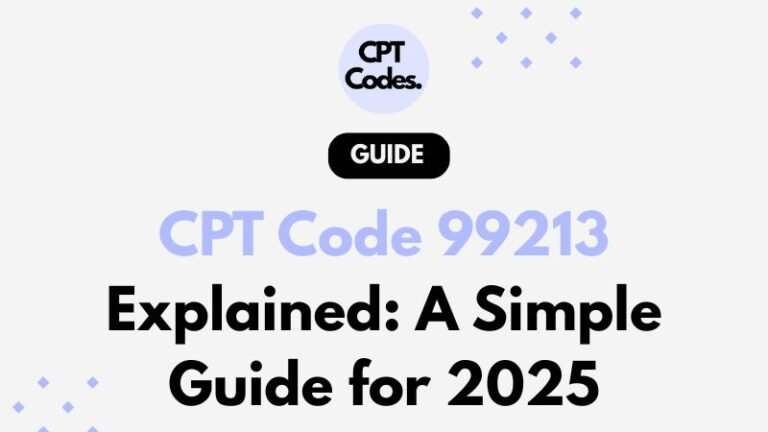What Is CPT Code 99213?
CPT Code 99213 is a Current Procedural Terminology (CPT) code used by healthcare providers to bill for an established patient’s office or outpatient visit.
It’s one of the most commonly used evaluation and management (E/M) codes in medical billing.
In simple terms:
CPT 99213 is a routine, low-to-moderate complexity visit for an existing patient that typically lasts about 20–29 minutes.
When to Use CPT Code 99213
You should use CPT 99213 when:
- The patient is already established in your practice.
- The visit involves a moderate level of medical decision-making (MDM).
- The provider spends 20–29 minutes of total time on the encounter (including documentation, review, and counseling).
- The condition being addressed is not highly complex but requires professional management.
Common examples include:
- Routine follow-up for diabetes or hypertension
- Managing stable chronic conditions
- Medication adjustments or refills
- Reviewing lab results and updating care plans
CPT 99213 Billing Guidelines (2025 Update)
Here’s what to know when billing CPT 99213:
- Patient type: Established only (not new)
- Time range: 20–29 minutes (total time)
- Documentation focus: Medical decision-making (MDM) or time
- Complexity: Low to moderate
- Typical settings: Office, outpatient clinic, telehealth
Pro Tip: If more time or complexity is involved, you might need to use CPT 99214 instead.
CPT 99213 Reimbursement (2025 Estimate)
While reimbursement rates vary by payer and region, the national average Medicare rate for CPT 99213 in 2025 is around $90–$100.
Private payers may reimburse slightly higher.
Always verify:
- Local Medicare Administrative Contractor (MAC) rates
- Payer-specific policies for telehealth or modifiers
Documentation Tips for CPT 99213
To ensure compliance and avoid denials:
- Record total time spent or level of MDM
- Note patient history, exam, and assessment clearly
- Include details of tests reviewed, medications adjusted, and care plan discussed
- Avoid copy-paste or vague documentation
CPT 99213 vs. 99214: What’s the Difference?
| Feature | CPT 99213 | CPT 99214 |
|---|---|---|
| Patient Type | Established | Established |
| Time (Minutes) | 20–29 | 30–39 |
| MDM Complexity | Low to Moderate | Moderate |
| Example Visit | Routine chronic care | Multiple conditions or medication changes |
Telehealth and CPT 99213
Yes, CPT 99213 can be billed for telehealth visits if:
- Both audio and video communication are used
- The visit meets all standard documentation and time requirements
- The payer allows telehealth billing for 99213
Use modifier 95 for telehealth claims when required.
Frequently Asked Questions:
Q1: Can CPT 99213 be used for new patients?
No. It’s for established patients only. Use CPT 99203 or similar for new patients.
Q2: How many diagnoses can I bill under CPT 99213?
You can list multiple diagnoses, as long as documentation supports the medical necessity.
Q3: What if the visit lasts only 15 minutes?
Use your clinical judgment and MDM level. If it’s below 20 minutes and complexity is low, consider CPT 99212 instead.
Q4: Does CPT 99213 cover labs or procedures?
No. Bill labs, procedures, or injections separately with their respective CPT codes.
Quick Summary:
- CPT 99213 = Office/outpatient visit for established patient
- Time: 20–29 minutes
- Complexity: Low to moderate
- Purpose: Routine management of stable conditions
- Commonly used by: Primary care, internal medicine, specialists
- Telehealth: Allowed with modifier 95
- Reimbursement (2025): Approximately $90–$100 (Medicare average)
Final Takeaway
CPT Code 99213 remains one of the most frequently used E/M codes in outpatient medicine.
To ensure proper payment and compliance in 2025:
- Use it only for established patients
- Document clearly and accurately
- Track time or MDM consistently
- Double-check payer rules
Proper understanding of CPT 99213 leads to better compliance, fewer denials, and improved revenue integrity.

